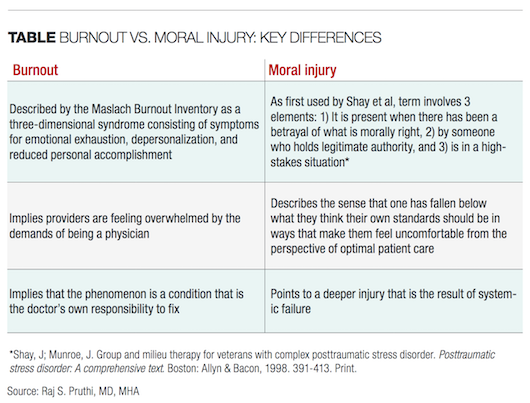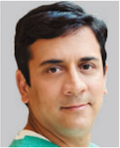Article
Are physicians faced with burnout? Or ‘moral injury’?
Author(s):
Burnout suggests a problem with providers themselves; a new term may be needed.
Editor's Note: To read a letter to the editor regarding this article, as well as Dr. Pruthi's response, click here.
One of the most commonly used research definitions of job satisfaction is by Locke, a psychologist who defined it as “a pleasurable or positive emotional state resulting from the appraisal of one’s job or job experiences” (Locke EA. The nature and causes of job satisfaction. Handbook of industrial and organizational psychology. Ed. M.D. Dunnette. Chicago: Rand McNally, 1976. 1297-349). This positive emotional state can stem from many factors, including work-life balance, compensation, growth opportunities, job security, and work environment.
As physicians, we deliver quality care to both the patient and public and often possess a passion to use one’s mind and hands. More recently, a growing duality between professional reward and the lamentable and impersonal business of medicine has placed undue pressure on physicians. Excessive paperwork, declining incomes, decreased independence, and commoditization have worsened in part due to government- and insurance-related burdens. Uncertainty, constant change, and growing pressures in the practice of medicine can degrade job satisfaction and contribute to overall unhappiness.

The consequences of this include negative effects on health care systems, patients, and certainly on providers themselves. Physician turnover and physician errors can prove to be financially costly to health care systems (Ann Surg 2010; 251:995-1000; Arch Intern Med 2012; 172:1377-85; Ann Surg 2009; 250:463-71; Am J Med 2003; 114:513-19). Regarding patient harm, physician burnout has been shown to be an independent predictor of medical errors (Ann Surg 2010; 251:995-1000).For physicians themselves, burnout has been linked to substance abuse, medical problems, depression, and the unfortunate outcome of suicide (Ann Surg 2010; 251:995-1000; Arch Intern Med 2012; 172:1377-85; Ann Surg 2009; 250:463-71;Am J Med 2003; 114:513-19 ; Arch Surg 2011; 146:54-62; Am J Prev Med 2000; 19:155-9). The rate of physician suicide is three to four times higher than that of the general population with almost 400 physician suicides per year-a number similar to losing almost three medical school classes each year (Arch Surg 2011; 146:54-62; Am J Prev Med 2000; 19:155-9).
What is burnout?
Burnout has been a useful term to describe the set of symptoms associated with this growing phenomenon. The term burnout was first used in 1974 to describe the symptoms related to occupational stress, and psychologist Christina Maslach developed the first widely used instrument for assessing burnout (Maslach C, Jackson S, Leiter M. Maslach Burnout Inventory Manual. Palo Alto, CA: Consulting Psychologists Press 1996). The Maslach Burnout Inventory operationalizes burnout as a three-dimensional syndrome consisting of symptoms for emotional exhaustion, depersonalization, and reduced personal accomplishment-acknowledging a number of other symptoms including physical exhaustion and feelings of ineffectiveness.
In the general population, the incidence of occupational burnout is 28%. In physicians, the incidence is almost twofold higher at 54% and appears to be rising (Arch Intern Med 2012; 172:1377-85). According to a recent Medscape report, the overall physician burnout rate is 44%, with urologists having the highest rate at 54% (Medscape National Physician Burnout, Depression & Suicide Report 2019, bit.ly/burnoutreport).
It is time to recognize that the term “burnout” may not capture the components of the injurious process itself. By focusing on existing symptoms of physicians and not underlying causes, the term “burnout” may overlook real potential solutions. The term may not help point to real solutions within our profession and the health care system in general. Burnout suggests that the fundamental problem lies with health care providers themselves.
Also see: Prior authorization takes its toll on urologists
Accordingly, health care systems and programs focus on physician resilience and wellness, including creating forums to discuss the problems and symptoms providers face and elective or urgent support programs (eg, “Code Lavender” and “Taking Care of Our Own”), which strive to ease provider stress and improve physician resilience. Hiring wellness officers and creating wellness programs are important steps to alleviate these symptoms of distress and burnout and provide support for the burned-out provider. However, they don’t address the underlying causes and thereby are inherently limited.
In addition, focusing on the symptoms of burnout alone may be shortsighted or a Band-Aid for a deeper injury. To this point, according to Robert McLean, MD, president of the American College of Physicians, “You can’t yoga yourself out of burnout” (“The real reason docs burn out,” Medical Economics Jan. 25, 2019, page 14).
Next:Burnout vs. moral injuryBurnout vs. moral injury
A more accurate term for what is occurring to health care providers may be “moral injury.” The term “moral injury” was first used by Shay et al to describe some symptoms experienced by war veterans (Shay, J; Munroe, J. Group and milieu therapy for veterans with complex posttraumatic stress disorder. Posttraumatic stress disorder: A comprehensive text. Boston: Allyn & Bacon, 1998. 391-413). According to Shay, moral injury had three components: 1) It is present when there has been a betrayal of what is morally right, 2) by someone who holds legitimate authority, and 3) is in a high-stakes situation. Since this original definition, other definitions have subsequently developed. The concept has been most commonly applied to the mental health of military veterans who have witnessed or perpetrated an act in combat that transgressed their deeply held moral beliefs.
More generally, moral injury refers to an injury to an individual’s moral conscience resulting from an act of perceived moral transgression, which produces profound emotional shame. The concept of moral injury emphasizes the psychological, social, cultural, and spiritual aspects of trauma. It is a normal human response to an abnormal traumatic event (Shay, J; Munroe, J. Group and milieu therapy for veterans with complex posttraumatic stress disorder. Posttraumatic stress disorder: A comprehensive text. Boston: Allyn & Bacon, 1998. 391-413).
In the context of health care, Wendy Dean, MD, and colleagues have recently used the term to explain the challenges facing physicians beyond burnout alone (“Physicians aren’t ‘burning out.’ They’re suffering from moral injury,” STAT, bit.ly/moralinjuryindoctors). According to Dean, the moral injury felt by physicians results from their obligations of electronic health records, their own student loans, hospital requirements for patient load and number of procedures performed, and government- or payer-related bureaucratic burdens-all while working toward the goal of trying to provide the best care possible to patients.
“How do you answer to all those masters and do what you pledged under the Hippocratic oath, which is always to work in the best interests of the patient?” Dean asks (“The real reason docs burn out,” Medical Economics Jan. 25, 2019, page 14). “With every patient encounter you’re in a bind and not able to do what you were trained to do. When this seeming betrayal happens every day it becomes a ‘death by a thousand cuts.’ ”
Moral injury can only be alleviated when the conflicting obligations beyond the Hippocratic oath-directed patient obligations are reduced, eliminated, or made not to be in conflict. This points to fundamental systemic changes in our health care delivery systems.
There are a number of solutions that may include removing the productivity demands on physicians or reducing EHR or other bureaucratic burdens that interfere with genuine patient care and welfare through elimination of these burdens or with physician support to offload these tasks. These solutions can come in many forms but will unquestionably require a change in focus on productivity metrics alone to allow providers to remain true to their Hippocratic obligations without conflict or unessential hurdles that result in moral injury. Once we eliminate moral injury, we begin to reduce burnout and improve physician morale and patient care.
Read: CMS data reveal trends in Part B drug spending
Although burnout versus moral injury may simply be a question of semantics, it is an important distinction to begin to make. Burnout implies providers are feeling overwhelmed by the demands of being a physician. By contrast, moral injury describes the sense that one has fallen below what they think their own standards should be in ways that make them feel uncomfortable from the perspective of optimal patient care. Labeling physicians as burned out implies that the phenomenon is a condition that is the doctor’s own responsibility to fix. Moral injury points to a deeper injury that is the result of systemic failure.
Conclusion
Clearing the way for physicians to provide high-level, compassionate care for their patients is central to addressing this burgeoning crisis in American health care. If we can return to this fundamental responsibility without obstruction or conflict, perhaps we can regain the tremendous personal rewards and fulfillment of our profession without the accompanying distress and moral injury.
To quote the Hippocratic oath: “Now if I carry out this oath, and break it not, may I gain for ever reputation among all men for my life and for my art; but if I break it and forswear myself, may the opposite befall me.”

Dr. Pruthi
is Rhodes Distin Professor and Chair of the department of urology, University of North Carolina at Chapel Hill.

Section Editor Christopher M. Gonzalez, MD, MBA,
is professor and chair of the department of urology at Loyola University Chicago Stritch School of Medicine, Maywood, IL.
Continue to the next page for a letter to the editor regarding this article.
To the editor:
Moral injury? Seriously? Are you kidding me? OMG, I need a time out, a safe place. Somebody get me a latte and avocado toast. We are now millennials, offcially. My new safety word is Rolex.
While I have no articles to quote, I did a survey of my office staff who raise families, take vacations, buy cars and pay 5,000 dollar deductibles on their health insurance all on 15 dollars an hour. While the study was limited in that it was not blinded, there was some contamination of the control arm and the R value was mixed, the study was clear. You cannot wear a Rolex watch, live in a gated community, drive a Lexus, vacation in Europe, send your kids to private schools and at the same time complain of moral injury or for that matter burnout. Further the study found that if you feel burned out, you need to quit your job and do something different. If you cannot quit your job due to outstanding debts for non critical creature comforts, the study responded with, “Well whose fault is that?”
Moral injury? I’ll tell you moral injury, I just lost my 22 year old son through an accident that never should have happened. Moral injury is my patient undergoing an 8 hour robotic partial nephrectomy for a 2 cm tumor, 3 hours of which were spent searching for a lost needle which was never found and for good measure, he gets a PE and DVT. All for a 2 cm tumor!
Moral injury is another AUS I put in another man who never should have had his robotic prostatectomy in the first place. Moral injury is operations and chemotherapy on patients who would be better served with hospice or benign neglect if only the RVU’s matched. Moral injury are these narcotics killing young people in rates higher than post-Tet Vietnam. Moral injury is the denial of health care to our fellow citizens. These type of things should raise outrage, not meaningful use or patient satisfaction surveys or MIPS or whatever is next. These things are no more than nuisance.
As for burnout, burnout is the great Dr. Charles van der Horst whose parents survived Hitler’s Germany. He was a pioneer in the treatment of HIV and nearly committed suicide due to the despair of seeing so many young men die of a disease the nation refused to acknowledge. Burnout is my colleagues in Haiti delivering 1,200 babies and treating 700 HIV patients on a budget that continues to shrink. Burnout is our psychiatric colleagues treating addiction with jail time.
In response to the rising issue of burnout or now moral injury, I would advise my colleagues to speak softly because, my studies show, nobody is gonna care, you’re making a lot of money, you have a lot of stuff and you’re still pretty much in control. As in, I am certain my receptionist would be happy to swap positions in life. The proper response to the physician version of moral injury is, to quote Natasha Romanoff of “The Avengers,” “cognitive recalibration.” We need to think differently.
I’ve pretty much given up on patient satisfaction because, I’m not here to make them happy, I’m not their friend I’m their advocate. Want a friend, go to the bar. I don’t answer emails because I’m not paid to answer emails, you want to talk about your findings, make an appointment.
As for Epic, I’ll do as little as I can, maybe less. And I’ll continue with my radio show, I got a new idea for a video deal I’ll bet fails. I quit the country club. My kids are in public school. My 12 year old Suburban is paid for and I’m gonna buy a MINI Cooper not a Porsche. I’m building a greenhouse. I’ll continue to put people on hospice even if it pisses off my oncology colleagues. I’ll continue to visit my hospice patients at their house and yea, I’ll keep making house calls because house calls bless me more than I help them. And I don’t work Fridays but if you need to be seen today, now, come on in I’m here and I’m working and I’m happy to help.
Scott Donaldson, MD / Hendersonville, NC
Continue to the next page for Dr. Pruthi's response.
Dr. Pruthi responds:
I drive a Honda Civic. I don’t own a Rolex. And, I have had the great privilege of working with Dr. Charles van der Horst for many years at the University of North Carolina. And, although Charlie was known for his outgoing personality and humor, he was very public about his struggles with depression and even suicidal thoughts due to the ever-increasing bureaucratic burdens of modern health care (bit.ly/charlesvanderhorst).
Charlie’s self-described symptoms were of a sense of not being able to fulfill the moral commitment to his patients-i.e. moral injury. “PTSD” as he described it (bit.ly/charlesvanderhorst). Unfortunately, his thoughts of suicide are all too familiar for physicians whose suicide rates are 3-5X the normal population with approximately 400 physicians dying by suicide each year-a number similar to two Boeing 737s full of physicians fatally crashing each year. This is not a perception or “millennial” problem, but a real and tragic issue facing our profession. And, this does not promise to get better for the next generation of surgeons. A recent study of surgery residents has shown that 75% of them meet criteria of burnout, 40% are depressed, and 1 in 8 have considered suicide in the prior 2 weeks (JAMA Surg 2018; 153:705-11).
I have the privilege of working every day with these thoughtful, intelligent, principled, and hard-working young men and women. None are worried about a Rolex or a Porsche. Nothing could be farther from the truth. They (and all of my colleagues) are worried about how to best care for patients. And, they have to accomplish this while overcoming the structural and operational barriers that exist to fulfill this moral and ethical obligation. They don’t have the luxury of taking Fridays off, buying a MINI Cooper, or planning the next storyline for a radio or TV deal. Or, certainly, despite our struggles with EHRs, most of us are not doing “as little as possible” with Epic notes and tasks.
We are here to do everything to take the best care for our patient and their family-even answer emails, write thoughtful and complete Epic notes, and respond to in-baskets. And, importantly, we are here to befriend a suffering patient who needs compassion, empathy, and genuine interest-what used to be called “bedside manner.”
Moral injury is a serious issue that is truly national, complex, and systemic-with effects beyond physicians-including impacts on patients and with truly societal implications. Dialogue that is belittling, snarky, and unserious does not address the despair that many providers feel resulting in too many physician suicides. We need to accept that this is important by admitting we are better for our patients when we are healthy, focused, and not conflicted.
Raj S. Pruthi, MD / Chapel Hill, NC
Newsletter
Stay current with the latest urology news and practice-changing insights — sign up now for the essential updates every urologist needs.
















